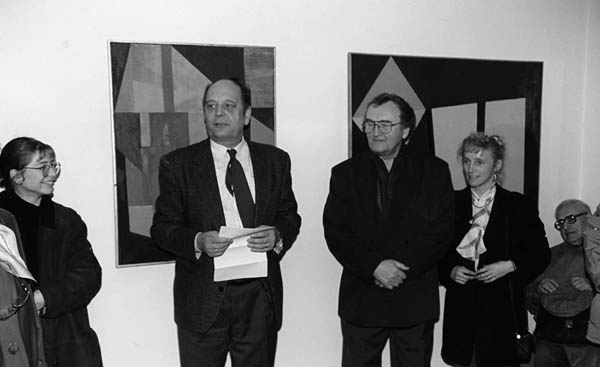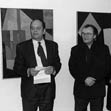texts about zs
Zdeněk Sýkora (1920) originally a landscape painter, produced, chiefly under the influence of Matisse and Poliakov, the highly generalising cycle Gardens which, for the last time, without mediation, interprets profound loyalty to nature.
Gardens belong to the period of his transition to the structures of the elements which then characterise his work from the year 1963 until 1974. This transition is played out in a process which the artist termed the searching for colour: thus he was creating compositions which were continually more flat, simplified and geometric; details of this important period (just before the structures of elements) may be seen in the completion of the painting Red Arrows (1936). The “geometrical equation” of the painting Three Quarters (1962), reproduced on this invitation, is, then, a former stage of Red Arrows which shows the classical De Stijl principle of “bringing out” formations in the picture. It is Sýkora´s searching for colour, a view of the birth of one of the most important elements of the Czech neoconstructivism of the 1960s, to which this exhibition is dedicated. Only a superficial and erroneous view (the same trait is seen in Malich whose early works were exhibited previously) could see in these works awkward beginnings which, perhaps, should best be concealed. On the contrary, the fact that Sýkora suppressed his strong immediate sensual relation to natural reality evidently resulted in his “abstractions” having more and more “concrete” content and from this he draws his ability to model all action, from physical and biological level to the sociological and profoundly spiritual.
Whether Sýkora, in his later works, places emphasis on order, perhaps only seemingly, perhaps only in opposition to the former immediate fascination by nature – in the structure of elements from the years 1963-1974, or whether he stresses in fact its other inseparable side, chance, as seen in his contemporary world famous line paintings; his works always remain models or parables which he achieved by dedicating himself only to the autonomous problems of art. His work is a unique proof of inward accord, harmony of the logic of the work of art with the logic of modern science.
The period of the searching for colour is the inseparable beginning of this way which has long been receiving qualified international recognition.



